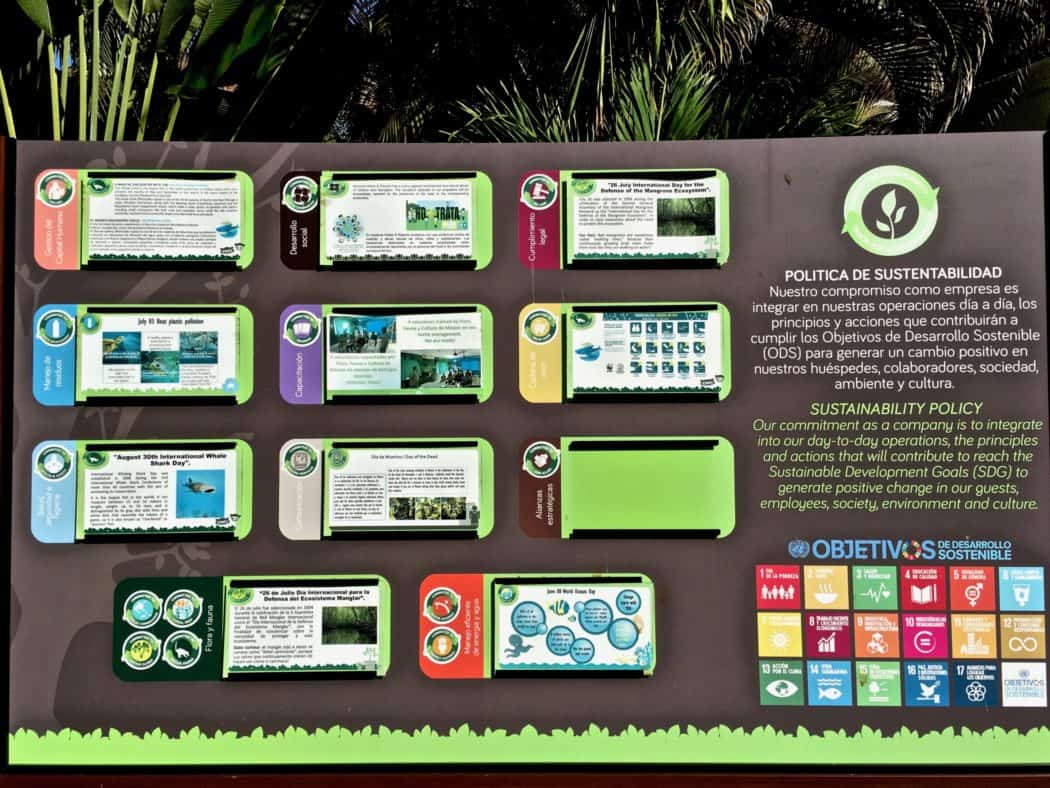Destination Stewardship Report – Summer 2022 (Volume 3, Issue 1)
This post is from the Destination Stewardship Report (Summer 2022, Volume 3, Issue 1), an e-quarterly publication that provides practical information and insights useful to anyone whose work or interests involve improving destination stewardship in a post-pandemic world.
Cultivating Comprehensive Destination Stewardship with GSTC Criterion A4

Criterion A4: Enterprise Engagement and Sustainability Standards
Destination stewardship requires good public policy and strong private sector practices. The Destination Management Organization (DMO) has a role in both, not just the first.
The DMO needs to provide guidance and encouragement to the private sector to operate more sustainably. That is the focus here: the DMO encourages continuous improvement on the sustainability practices of the businesses that are directly serving the visitors.

A resort on Mexico’s Riviera Maya posts its allegiance to the UN’s SDGs. [Photo by Jonathan Tourtellot]
Sustainable consumption in tourism is far more than tangible products, such as food and souvenirs purchased by the visitor. Consumption in tourism includes more money and time spent on services than on physical products. Those services include accommodations, transportation, guiding and interpretation, and the attractions visited. A broad view of sustainable tourism products and services is needed, one that looks at the core elements that all visitors require.
Businesses serve the visitor directly. Businesses operate the physical facilities and modes of transport that visitors use. They also provide most of the less tangible services and experiences.
Criterion A4 of the GSTC Destination Criteria and its Performance Indicators underscores that DMO’s must take an active role in engaging with the private sector. This is needed to encourage more sustainable forms of services and experiences. Let’s look at the text:
A4 Enterprise engagement and sustainability standards
The destination regularly informs tourism-related enterprises about sustainability issues and encourages and supports them in making their operations more sustainable. The destination promotes the adoption of sustainability standards, promoting the application of GSTC-I Recognized standards and GSTC-I Accredited certification schemes for tourism enterprises, where available. The destination publicizes a list of sustainability certified enterprises.
Performance Indicators for Criterion A4:
- Evidence of regular communication of sustainability issues to tourism-related businesses (media, meetings, direct contact etc.).
- Sustainability support and advice to tourism-related business – available and promoted.
- Number and percentage of businesses certified against tourism sustainability standards (and whether GSTC recognised/accredited), with targets for wider outreach.
- Evidence of promotion of certification schemes.
- List of tourism-related certified enterprises, kept up to date.
This criterion calls for an active role by the DMO in encouraging and/or requiring businesses to operate more sustainably. DMOs can do so in a variety of ways:
- Awareness-raising through seminars, newsletters, classroom training, etc.
- Incentives for good performance, such as discounts in tourism promotion activities for businesses with evidence of sustainable practices
- Subsidies for good performance
- Mandates for good performance
In other words, carrots and sticks, with as many carrots as possible … but sticks when necessary.
Examples of carrots, that is, encouragement, incentives, and subsidies:
- Costa Rica’s national government operates a tourism business certification scheme for sustainability, and provides discounts to certified businesses for presenting their business at international trade fairs and other forms of international promotion.
- Singapore set a target that 60% of hotels gain certification to the GSTC framework by 2025 and are encouraging businesses to adhere to the goal in a variety of ways.
- Jeju Island, a province in South Korea, set targets for full conversion to electric vehicles (EV’s) that included several years advance notice before an eventual mandate that will require all rental car companies to convert fully to EV’s in their fleets.
An example of mandates comes from Türkiye, where the Ministry formed an agency to develop and operate a Green Tourism program. Included in this is a mandate that all hotels in the country gain certification by GSTC-accredited Certification Bodies by 2030. Those hotels not in compliance will be subject to losing their business licenses enforced by Türkiye’s central government. But the mandate is softened by the implementation of a stepwise scheme. This allows for each hotel to climb a ladder to certification via two steps. The hotel provides evidence of compliance to the national standard at each step (the national standard complies with the GSTC Criteria formally through the GSTC Recognized program). This process must be completed between 2022 and 2030.
Making It Verifiably Systemic
It’s useful to break down systematic approaches to sustainable tourism into these elements:
- Attributes – such as greenhouse gasses, energy, plastic, fair labor practices, cultural heritage preservation, ecosystem conservation, animal welfare.
- Measurement – as shorthand for measuring, evaluating, rating, scoring, and reporting.
- Verification – providing evidence that you are managing and making improvements on the attributes you claim to be improving. This can include awards or certification, or any form of reporting that is reviewed to some degree by external and impartial parties – i.e., objectively verifiable. (Self-assessments or any form of “self-verification” are not truly verification — let’s call it “talking about yourself.”)
DMO’s should not be boastful if their local businesses are striving for improvement in only a very few attributes. “We recycle” is a wonderful claim, but are you doing anything else?
Are you measuring and benchmarking and rewarding improvement? Are you measuring how much actually gets recycled in those lovely bins scattered about? Are the businesses seeking external and impartial verification of their claims? The guests can see the recycle bins, but they cannot see back of house whether the sorting continues; that requires external verification through auditing.
All of these are essential.
And, let’s be honest: Even if a DMO is doing great work on complying with GSTC-D Section A on Sustainable Management, if they are not encouraging and rewarding excellence by the businesses within their jurisdiction, can they make any claims of sustainability as a destination? I think not. Criterion A4 is vital to the compliance of Section A in its entirety.
A “sustainable destination” should be a combination of both DMO and the private sector achieving this recognition together. In other words, the DMO and other public agencies must collectively score well on Section A of GSTC-D – AND the private sector should have gained high percentages of strong, meaningfully verified progress on their journey to sustainability. Hotels should have their buildings certified by LEED, BREEAM, or similar and their operations certified by a GSTC-Accredited Certification Body. Tour operators, agencies, and transport companies should have high percentages of clean energy vehicles in use and should be certified sustainable themselves. Other businesses are part of B-Corp, constantly working to increase their scores.
We at GSTC are working on systems to count hotels at destinations in order to determine the percentage that are certified sustainable. We’ll seek ways to do the same for Destination Management Company (DMC)’s, such as local inbound operators and transport providers. This relates directly to Performance Indicator “3” of Criterion A4.
Criterion A4 speaks to all of the above. How many of a destination’s businesses are seriously addressing what number of attributes? Are they properly measured, with external verification? Without such significant metrics, a destination’s claim to being “sustainable” rings rather hollow.
About the Author
Randy Durband has had two careers in travel and tourism – twenty-plus years in senior leadership positions at some of the finest U.S. tour operators. Following that, in his second travel and tourism career, Randy advanced the work of Sustainable Tourism as an advisor, consultant, and speaker. He brings his knowledge of the business of travel, his global network of travel professionals, and a passion for sustainability to support the GSTC and the general sustainable tourism movement.




